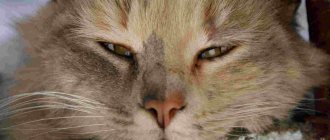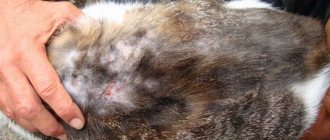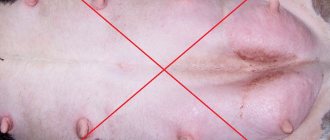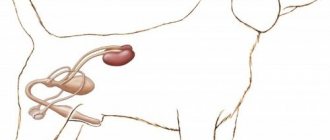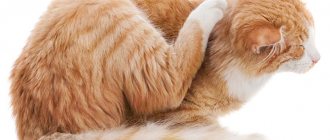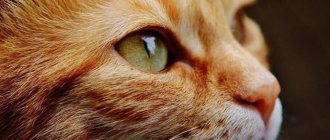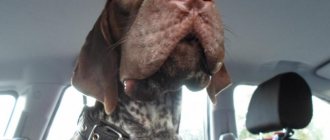Trichophytosis in cats is an infectious disease in which areas of the skin appear with signs of flaking, hairs broken off at the base or with severe inflammation and a thick crust. Fungi of the genera Trichophyton, Microsporum, Achoreon cause 3 different diseases - trichophytosis, microsporia and scab. Microsporia and trichophytosis manifest themselves similarly, so they are combined under the popularly known name - ringworm.
Microsporia in cats is caused by fungi of the genus Microsporon. This disease is dangerous not only for animals such as cats, dogs, rats, but also for humans. The spores of the disease are all around us: both in the air, on the grass and/or on the ground, and on the skin of animals, people, their clothes, shoes.
Description
Dermatomycosis is a skin disease caused by opportunistic fungi. There are several genera, among them the genus Microsporum. It includes more than twenty species, divided into three groups: zoophilic (more often found in animals), anthropophilic (human), geophilic (living in the soil).
All of them are potentially dangerous to people and animals. But this does not mean that fungus always causes disease. Typically, spores that get on the skin or fur are destroyed or inactivated by the protective flora. However, if immunity is reduced or susceptible from birth, microsporia develops in cats, dogs, and humans.
Under favorable conditions, spores that fall on the skin germinate, penetrating into the hair follicles. As the fungus multiplies, it destroys the follicles, causing the hair in the affected area to break off or fall out. Toxins are carried throughout the body in the blood. In severe cases, exhaustion increases - it is rare, but microsporia in cats can lead to the death of the pet.
In adults, mycosis usually occurs without significant symptoms. Children are more often infected; outbreaks appear a week after contact. Itchy spots disappear after using a topical remedy. Fungal infections are truly dangerous for people with severe immune disorders. You cannot neglect the rules of personal hygiene, but you should not be afraid of microsporia in cats.
Pathogen
Microsporum spores are ubiquitous. A cat whose entire life is spent in an apartment becomes infected with microsporia from the owner, who brings fungal spores on the soles of his shoes. Spores can wait in the wings for years and, under stress, infection, vaccination, or exacerbation of permanent diseases, become active, germinate and feed.
recommended articles:
- Grooming a cat, is it worth using scissors?
- Papillomas and warts in cats
The hunting instinct can fail a successful predator cat: mice are a reservoir of infections, including Microsporum.
Fungal dermatitis
Causes and routes of infection
There is always a certain amount of fungal spores on human skin and animal fur. They fly in the air, landing on the ground and clothes. But in cats, microsporia more often occurs after contact with a sick animal, common care items, or bedding. Rodents only carry it, rabbits carry it and get sick themselves.
Free-ranging cats are at risk. Places of increased danger - basements, entrances, veterinary clinics. It is believed that young animals are more susceptible to infection, but this is not entirely true. Microsporia in kittens is more common due to the fact that low resistance to fungi is detected at an early age.
Such animals, like children with susceptibility to mycoses, are virtually doomed to get sick. But some species of Microsporum penetrate the defenses of even healthy immunity. Sometimes one’s own flora becomes pathogenic due to a decrease in protective forces due to a weakening factor:
- hunting period, pregnancy, childbirth, lactation;
- Cat rabies
Microsporia
Calcivirosis
stress, diseases of internal organs;
- fleas, worms, viruses, bacteria;
- taking drugs that suppress the immune system;
- metabolic disorders, improper conditions of detention.
People become infected with microsporia from cats, and vice versa - this is not uncommon. For example, some species of geophilic fungi are pathogenic for cats. The owner brings the spores home after washing his hands poorly after working at his dacha.
Prevention of microsporia
All prevention of microsporia is as follows:
- If the area is unfavorable due to illness, you should not let the cat go outside again, thereby protecting it from contact with stray animals.
- For walks on the street, it is better to use a harness that will prevent the animal from running.
- Your pet should be vaccinated against microsporia at least once a quarter.
- Do not develop other diseases that lead to a severe weakening of the immune system.
Symptoms
Unbearable, exhausting itching, due to which the cat scratches until it bleeds, is considered an integral sign of lichen. But whether your pet itches or not doesn’t mean anything. The same itching is accompanied by flea dermatitis; sometimes microsporia occurs without this symptom.
In the classic version, the disease begins with redness of the skin, which is not visible under the fur. After a few days, the fungus destroys the hair and clearly defined bald patches form. Usually this is the head, armpits, stomach, tail. Then the hairless spot becomes covered with grayish crusts.
Microsporia in cats comes in 4 forms:
| Form | Explanation |
| Hidden (subclinical) | Individual hairs or a small group of hairs are affected. Apart from constant shedding, there are no symptoms. As a rule, it goes unnoticed by the owner. Healthy adult cats are more likely to get sick. |
| Erased | Small bald patches or one. For years without inflammation, do not grow, do not itch. It turns into a superficial form in case of decreased immunity. |
| Superficial | Reddened, hairless areas covered with scales. Inflammation affects the upper layers of the skin. The most common form of microsporia in kittens and young animals. |
| Deep (follicular) | Bald patches are red or bluish, swollen, oozing lymph and pus. Secondary infection, deep layers are inflamed. A consequence of an untreated superficial form or high susceptibility. |
In severe cases, secondary infection leads to a deterioration in general condition. The temperature rises, the eyes and nose are running, the lymph nodes are enlarged. Lichen spots become covered with blisters, in place of which non-healing ulcers form. The cat drinks a lot, appetite decreases, and apathy increases. Without treatment, the pet may die.
Diagnostics
Treatment for microsporia cannot be started only on the basis of anamnesis and examination - cats have many similar diseases. It is important to exclude infection with subcutaneous mites, non-infectious dermatitis, scab, trichophytosis, and other dermatomycosis. The spots are viewed under a Wood's lamp - the spores luminesce with a bright emerald color.
Even if there is no glow (not all types of mushrooms glow, especially on black wool), express testing is carried out - hairs taken from the periphery are examined under a microscope. It is important to ensure that the material is taken from the edge of the hairless area. In the center of the spot, most likely, the fungus is no longer present.
Inoculation on a nutrient medium is carried out in all cases of microsporia to determine the type of fungus. You will have to wait 10 days for the result, but it will help you choose an effective remedy and determine whether mycosis is contagious to people. Drugs of random choice provoke the transition to a latent or erased form that is difficult to treat.
To assess the condition, a general and biochemical blood test is performed. This will help identify the pathology that led to a decrease in immunity - in 80% of cases it is present. The level of eosinophils, leukocytosis, and monocytosis make it possible to judge how severe the disease is and how effectively the immune system responds.
Treatment
If you find spots that look like lichen, you should not treat them - ointments, especially antifungal ones, complicate diagnosis. If your pet is itching a lot, you can give Stop Itching or inject Suprastin intramuscularly at 0.1 ml per 1 kg of weight. You should consult a doctor as soon as possible.
Basic treatment
Most veterinarians immediately offer to inject the vaccine - Polivac, Vakderm. But this is heavy artillery if nothing else helps or the disease is severely advanced. The effectiveness of such vaccines is still being discussed, they place a heavy burden on the immune system, and the consequences can be very severe, including death.
The treatment regimen for microsporia in cats is aimed at destroying the pathogen in three ways:
- antifungal tablets or injections - Fluconazole, Nystatin, Griseofulvin with liver support with hepatoprotectors;
- increasing immunity - Tsamax, Gamavit, Interferon;
- external treatment - ointments for single spots, spray for extensive lesions: Zoomikol, Miconazole, YaM, Vaganova, Fungiderm.
Based on symptoms, medications are prescribed for itching, painkillers, and antipyretics. Antihistamines and hormones are used to suppress an allergic reaction. To combat advanced secondary infection, a course of antibiotics is prescribed. Treatment is considered ineffective if there is no noticeable improvement after 8 weeks. In this case, it is advisable to vaccinate.
How to treat the disease at home
At home, the veterinarian's prescriptions are carried out. It is impossible to cope with the pathogen by self-medication, so do not waste time.
First aid for a pet
The first aid for a pet when flaking, scales, areas of thinning hair or baldness are detected on its skin is to take it to a veterinarian for examination and diagnosis. There are many diseases that are characterized by focal hair loss, and not all of them are skin diseases. Under no circumstances should you bathe your pet. This will provoke the spread of fungal infection to new areas of skin and fur, forming large areas of fungal infection.
Treatment regimen depending on the stage of the disease
For limited skin lesions and the general satisfactory condition of the animal, treatment is carried out with the daily use of local antifungal agents - solutions, ointments, sprays.
If the lesion is widespread, especially if the claws are infected, as well as if local therapy is ineffective, systemic antifungal agents are used. Additionally, you may need drugs from other groups, for example:
- keratolytics - with a pronounced peeling process and thickening of the epidermis due to fungal infection to facilitate the penetration of the active substances of local antifungal drugs;
- antibiotics - for secondary bacterial dermatitis;
- hepatoprotectors (drugs to protect the liver) - as a cover against the hepatotoxic effect of systemic antifungal drugs;
- immunostimulants - for extensive lesions.
Some veterinarians are categorically against B vitamins during the treatment of microsporia, believing that this group of vitamins “strengthens” the pathogen more than the patient.
Photo gallery: skin lesions with microsporia in cats
Kittens under one year old are easily infected with microsporia due to the immaturity of the immune system
Microsporia often affects the paws and tail
The location of the focus of microsporia in the ear area often causes external otitis
Microsporia causes damage to the skin of the paw pads, interdigital spaces, and claws, leading to their deformation
Medicines for local treatment of microsporia
Medicines for local treatment of microsporia can be used alone or in combination with drugs for systemic therapy.
Ointments
Ointments are used to treat small infected areas. Their use is often limited by the fact that cats lick them off. Use ointments and creams:
- antifungal action: Miconazole;
- Ecodax;
- Mycoseptin;
- Nizoral;
- Clotrimazole;
- Sulfuric ointment;
Solutions
To treat microsporia, it is possible to use solutions:
- imaverol - perform bathing and spraying;
- thermikon - a convenient form in the form of a spray;
- Exoderil.
Solutions are applied both along the coat and against hair growth.
Shampoos
Shampoos have a short-term effect and are not used independently for treatment, but they can have a positive effect. Shampoos used:
- Doctor;
- Veterinary Formula ANTISEPTIC & ANTIFUNGAL;
- Nizoral.
The use of shampoos allows you to both reduce the amount of pathogen on the cat’s skin and fur and prevent contamination of the surrounding area with spores
Drugs for systemic therapy
Drugs for systemic therapy are prescribed for a long time, the minimum course is 6–8 weeks:
- itraconazole (Sporanox, Irunin, Intranox) is the most effective drug for the treatment of ringworm in cats;
- terbinafine;
- fluconazole;
- griseofulvin (Grizon-250) is an older and toxic, but effective drug, now practically not used.
Vaccines
Since the presence of a fungal infection of the skin characterizes a weakness of the immune system, in some cases the use of vaccines seems advisable. They contain inactivated fungal spores as an antigen and are prescribed both for therapeutic purposes (“provoking”, preventing the pathogen from becoming chronic and promoting its maximum destruction by antifungal agents), and for prophylactic purposes (to build immunity and resistance to infection with skin mycoses) .
There is a nuance here - the vaccine stimulates the production of antibodies, while the body uses the cellular component of immunity to fight a fungal infection, so not all doctors use vaccines, and they do not use them at all outside the Russian Federation.
Veterinarians use vaccines:
- Microderm;
- Polivac;
- Vakderm.
For preventive purposes, they are used twice with an interval of 2 weeks; immunity is developed a month after vaccination. For therapeutic purposes, the vaccine is administered 3 to 5 times. The decision on the need for vaccination is made only by a veterinarian based on the characteristics of the course of the disease. Vaccination is not widely used for either treatment or prevention of the disease.
Table: overview of medications used to treat microsporia
| A drug | Compound | Operating principle | Price, rubles |
| Irunin | Itraconazole | Systemic antifungal agent. Give with food. Do not use for:
May worsen appetite. It is the most effective and safe of systemic drugs, suitable for use in kittens weighing more than 2 kg. | from 237 |
| Imaverol, emulsion | Enilconazole | Antifungal agent for local action. It is characterized by high efficiency and low toxicity, since the active substance does not penetrate into the blood. Used to treat kittens and pregnant cats. A working solution is prepared from 1 part Imaverol and 50 parts warm water. It must be used within 24 hours. The affected area is treated with the resulting solution, covering its borders against the growth of the hair. | 2990 |
| Thermikon, spray | Terbinafine | Broad-spectrum antifungal agent for topical use. Before application, the affected areas are cleaned with soapy water and dried. Apply 2 times a day. | from 220 |
| Clotrimazole, ointment and cream | Clotrimazole | An antifungal agent for topical use, has the ability to be absorbed into the blood and have an embryotoxic effect. Not prescribed during pregnancy. Apply 2-3 times a day. | from 43 |
| Shampoo Nizoral | Ketoconazole | The shampoo is applied to the wool, foamed, left for 5 minutes, then rinsed off. Apply once every 5 days for a course of 2–4 weeks. You should not let your cat lick the shampoo. Use during pregnancy - if the expected benefit outweighs the expected risk. | 950 |
| Yam ointment |
| It has antifungal, antimicrobial and keratolytic effects. Apply 1–2 times a day to the affected area, exceeding its area by 3 cm. The course is 8–10 days. Do not lick the ointment. | 50 |
| Shampoo "Doctor" | Climbazole | It has an antifungal effect, eliminates irritation, and deodorizes. Leave the shampoo foam on the cat’s fur for 5–7 minutes and rinse off. Apply once every 3 days. Causes increased peeling of the skin. | 280 |
| Veterinary Formula ANTISEPTIC & ANTIFUNGAL shampoo |
| It has antifungal, antimicrobial and antipruritic effects. Lather the product, rub into the cat’s skin, and leave for 5–10 minutes. Apply twice a week for a course of 6–8 weeks. | 400 |
| Microderm vaccine | Inactivated spores of fungi that cause trichophytosis and microsporia | Vaccine for the prevention and treatment of trichophytosis and microsporia. It is administered intramuscularly and is used in kittens from 1.5 months. Contraindications:
| 150–200 |
Photo gallery: medications for the treatment of microsporia
Imaverol is a drug based on enilconazole, used in the form of a diluted emulsion
Irunin is a synthetic drug with a broad spectrum of action, its use causes the death of pathogenic and conditionally pathogenic fungi
Microderm is a drug that is intended for the prevention and treatment of microsporia and trichophytosis, that is, dermatomycosis in cats and dogs.
Thermikon is a spray with antifungal action intended for external use.
Veterinary Formula ANTISEPTIC & ANTIFUNGAL shampoo - antifungal and antimicrobial shampoo that relieves itching and eliminates the symptoms of fungal dermatitis
Nizoral is one of the most effective antifungal agents for cats.
Effective folk remedies
There are no folk remedies for microsporia. This infection poses a threat to both other domestic animals and humans, as well as regular labor costs to disinfect the sick pet’s habitat, and therefore requires effective treatment. You should not waste time and place your hopes on folk remedies.
Rules for medical procedures
When treating microsporia, it is not customary to use more than 2 different forms of antimycotic agents in order to prevent their toxic effects during accumulation. Therefore, the total amount of active ingredients in both used products is taken into account - both for local and systemic effects.
You should not interrupt the course of treatment with antifungal agents without good reason, for example, if an allergy occurs, as this may result in the development of drug resistance in the pathogen.
When applying local products, the following rules should be followed:
- If the surface intended for treatment is covered with dried exudate or epidermal scales, it should be pre-treated before applying the antifungal drug:
- Soak the skin scabs with warm water or 3% hydrogen peroxide and remove.
- Treat the area with a 1–2% aqueous solution of chlorhexidine.
- Treat the skin with a 1:1 mixture of salicylic acid 10% and alcohol tincture of iodine 5%; Treatments should be carried out every other day for 6–10 days.
- Apply an antifungal agent (ointment, cream, spray).
- It is better to apply solutions both along the fur and against its growth - for reliability, covering healthy areas along the radius of the lesion up to 3 cm.
- Shampoos and ointments should not be licked off. You can use a protective collar.
To prevent licking of medications, it is recommended to wear a protective collar on your cat.
The effectiveness of treatment is assessed by visual criteria, as well as laboratory data. If clinical signs of microsporia disappear, treatment procedures should be continued until 2 consecutive negative laboratory tests are performed with an interval of 2 weeks. Only in this case is the cat considered cured.
Video: treatment of lichen in pets
Caring for a sick animal
In all cases of microsporia, it is necessary to discuss with the veterinarian the living conditions of the animal, since they may need improvement, especially nutrition. Measures are taken to isolate the sick animal, especially from children, the elderly and other pets.
The question of the need to completely cut the hair of long-haired cats is ambiguous, since, on the one hand, this makes it easier to treat the affected areas, on the other hand, cutting always entails microtrauma to the skin and contributes to the spread of fungus. The tools used to groom the cat also become infected, and without treatment (dry heat oven, paraformalin chamber, alkali and formaldehyde solutions) become a source of infection. Therefore, the need for a haircut for each animal is determined individually by the attending physician. In case of focal damage, healthy hair around the area is cut to 2–3 cm; it is better to burn the cut hair and disinfect the scissors.
Caring for a sick pet is carried out using gloves; to prevent infection of clothes, you can use disposable capes from the pharmacy, shoes - shoe covers, and tuck your hair under a cap. After contact with your pet, wash your hands thoroughly with soap, or wipe them with an aqueous solution of chlorhexidine.
You will have to pay a lot of attention to cleaning the room. The use of a vacuum cleaner is questionable, since models with a bag blow air (and spores) back. When using washing vacuum cleaners, spores will get into the filters, and then back into the air after the filters dry. Therefore, it is better to clean with a mop - for smooth surfaces, a steam generator - for upholstered furniture and carpets, and cat houses. To wipe furniture, it is preferable to use Imaverol solution - it will not spoil it; it is also possible to use Clinafarm smoke bombs in the apartment.
Clinafarm contains enilconazole, a synthetic broad-spectrum fungicide that has a detrimental effect on fungi and their spores; the smoke, unlike other agents, penetrates into all crevices
For non-capricious surfaces, wipe with solutions:
- chlorine bleach 1:10;
- 1–2% chlorhexidine solution;
- 2% glutaraldehyde;
- 3% chloramine solution.
Textiles used by the cat are washed in hot water with chlorine bleach if possible, then ironed with a hot iron. Those items that cannot be reliably processed should be assessed for the possibility of their disposal.
